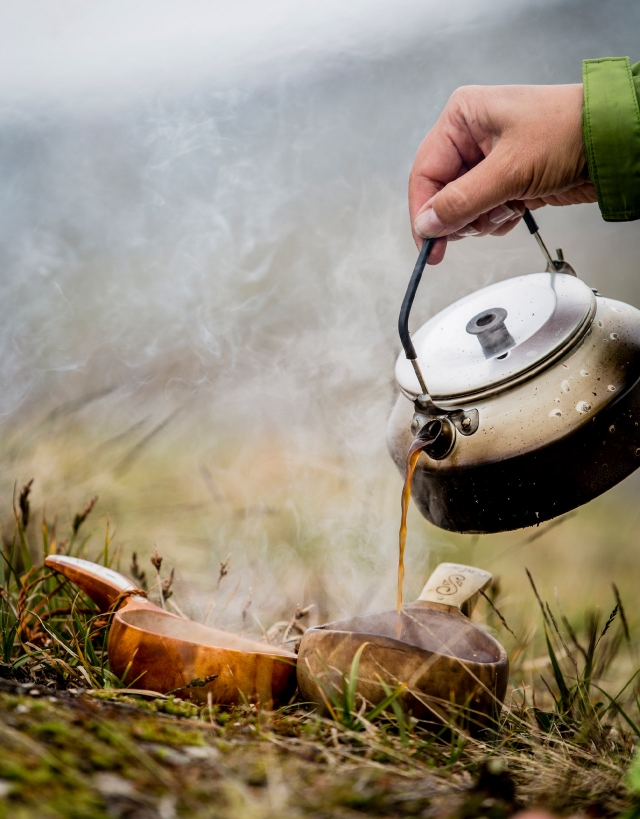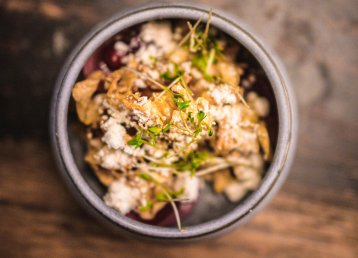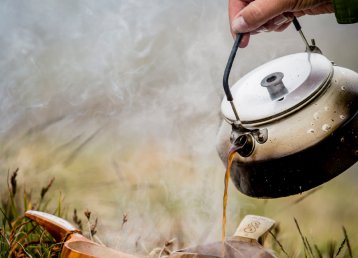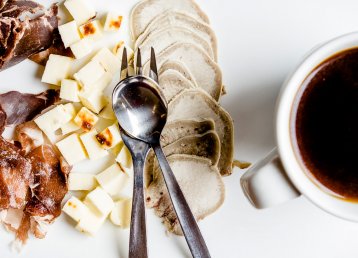Perhaps the smallest restaurant in the world. In Kaalasjärvi between Kiruna and Nikkaluokta, in the middle of a straight part of the road that feels awfully long, a sign indicates the turnoff for Arctic Gourmet Cabin. Today the sign is covered in frost and not easy to spot, so even if you have been here before you appreciate the assistance from Google Maps. The Löfgren family cars are parked in the driveway and Malin is about to head into Kiruna, taking the oldest daughter horse riding. In the restaurant – measuring less than 10 square metres – Johan is preparing tonight’s dinner. Once we have greeted each other he says:
“We’ll start with champagne, right? It’s always a nice way of starting a dinner, isn’t it? This champagne, from Yann Alexandre, will work perfectly with the first starter. What do you think?”
Well, what is there to say about a glass of champagne as you step into a small, warm cabin from an outside temperature of minus 25 degrees Celsius?
“Of course. That sounds amazing.”
A lovely name
Johan serves us champagne and then runs over to the kitchen where he is preparing the food. The door opens, carefully. A small boy, not wearing enough clothes by far for this winter evening, sneaks in.
“Hello!”, says Anna from England. The boy looks shy to start with.
“Hello!”, he replies.
Anna runs with this opening and asks:
“And what might your name be?”
“Zacharias.”
“Oh, that’s a lovely name. Do you have a nickname that friends call you sometimes – like Zach, for example?”
“No, not really”, says the boy who turns out to be seven years old, “at least not Zach.”
"The concept ‘home food’ is nothing new — inviting people to your home is perfectly normal"
A while later we find out that of course Zacharias has a nickname, but in Sweden we use ‘Zacke’ rather than Zach. When Johan returns with the first starter – Alpine whitefish roe from Langas traditionally accompanied with dill, lemon, red onion and smetana – we tell him that we have had the pleasure to meet his adorable son.
“Ah well, nothing wrong with that lad. Especially not on days when he doesn’t try to burn down the house!”, Johan laughs and then runs over to the house to make sure everything is ok with both Zacke and all that is cooking on the stove.
Nothing new
The concept ‘home food’ is nothing new. Inviting people to your home is perfectly normal. But turning it into a business is something completely different. In Italy the slow food movement has been marketing various cesarine for a long time. They are selected chefs who have taken it upon themselves to teach people from all around the world about Italian food traditions – in their homes. A wonderful initiative.
Here in the smallest restaurant in the world it is very easy to follow Johan as some of his dishes are created. He started as a chef in his hometown Örnsköldsvik, then went north and worked at Icehotel for many years until his wife Malin, a sommelier, and he decided they wanted something else for their life together. They had just bought a house and started a family, and wanted to scale down, slow down, commute less, be at home more. All this without missing out on working with the travellers of the world, and with food.
So, they opened the smallest restaurant in the world in Kaalasjärvi outside Kiruna. Then they built two rooms for the four guests they can accommodate, and a sauna. Our main course is a grilled reindeer fillet with hand-picked funnel chanterelles, grated apples from Skåne, pureed celery root and fried pork belly. Once it is served, paired with a magnificent Sfursat from Valtelina, the evening is already complete. The scrumptious chocolate fondant with cloudberries that arrives a little later is just a bonus.
The world’s smallest restaurant
Maybe it’s the world’s smallest restaurant? On some nine square meters in the backcountry of Swedish Lapland, you’ll find two tables, four chairs and one chef in the kitchen making great food out of local staples. And outside the Arctic Gourmet Cabin in Kaalasjärvi, the northern lights often calls for a pause in the dining.
With a touch of celebration
Njálgge is the Sami word for tasty – tasty with a touch of celebration. Together with food creator Eva Gunnare, Gunnarsbyn, and reindeer herder Helena Länta from Jokkmokk, Njálgge is also an unparalleled food adventure spanning over more than 20 courses, inviting you on a journey for all senses through Sápmi’s eight seasons. Eva starts by serving a nettle soup. We are in the season known as spring-summer, or gidá-giesse as it is called in Lule Sami. Those visiting the Arctic destination Swedish Lapland will see that meat, preferably game, is a big part of food culture. This is also the case with Njálgge, but here there is also a deep-rooted knowledge of what plants the indigenous people were eating. Knowledge that has all but disappeared in our modern age.
“It’s been important for me to not just create food experiences, but also to make sure that the experiences transmit knowledge. We have an inheritance to safeguard.”
Hunting being an essential part of Arctic culture was perhaps not mainly about people wanting sinewy meat to chew. It was more about the hunt providing clothes for winter, for survival. Reindeer fur is a lot better than birch leaves if you want to keep warm. On the other hand, early birch shoots might be just the energy and vitamins you need to revive yourself after the hibernation of winter.
"Hunting being an essential part of Arctic culture was perhaps not mainly about people wanting sinewy meat to chew"
The delicious nettle soup is followed by the first vegetables of spring: fried willowherb shoots. The four-inch-long shoots are crunchy and sweet. Early in the year they can be eaten raw, but they get a different, savoury flavour when fried. There is bark flour bread on the table, and butter flavoured with dried juniper berries. To archaeologists, places where pine bark has been collected are a clear sign of early northern inhabitant settlements. The bark was collected in spring when it was full of water. The gatherers would either chew the bark straight away, or dry it to be used later in bread, for example. During the war years in the beginning of the 20th century, bark was used extensively when flour was difficult to find or expensive. Today science has shown that flour from dried pine bark, as well as the inner part of birch bark, is extremely healthy and that poor man’s food from the war years was a proper health regime. I grab an extra piece of bread. With a lot of butter.
An opportunity to learn
Spring-summer gives way to summer, giesse, and then autumn-summer and autumn, tjaktja-giesse and tjaktja– the true times of plenty for hunters and gatherers. Eva serves fish, mushrooms, berries and, of course, reindeer. Some years ago, at a different celebration, I had a meal with Helena and Eva. They served reindeer that had been slaughtered that same day. You rarely get a chance to eat meat that is absolutely fresh, but we did on that autumn day. To the Sami it is a given that when the first reindeer stags – sarv – are slaughtered in autumn, there is a meal of reindeer meat at the place where they are gathered for separation. A difficult life can also be a celebration.
Today we enjoy a table filled with candied angelica stalks, treats made from all kinds of berries, fried chanterelles, seeds from alpine bistort, and a cheese from Vuollerim, served with a divine bird cherry syrup. The entire meal is accompanied by Eva and Helena telling interesting stories and singing wonderful joiks. More than being an incredible celebration, Njálgge is an opportunity to learn. I make a mental note to be more active, picking the first vegetables of spring in the shape of nettles, fir shoots, shoots from willowherb, and the earliest birch leaves – when they look like tiny green ‘mice ears’ – and that dandelion shoots are a pure delicacy. I will learn to use them fresh and try to pickle them to use as flavour enhancers. I also decide to dry some northern bilberries. They taste pretty much nothing when they are fresh, but when dried they become a proper ‘super berry’ – the raisins of the forest land.
"This is also a place where traditions inherent to the place create a backdrop for the tasty food being created"
Indigenous food is an interesting expression. I stumble upon the term when I get hold of the cookbook Aittaabout indigenous food with roots in the Sami and Tornedalian food culture, written by Per Huuva from Liehittäjä. Once upon a time it was food, the plentiful nature, that brought the people here. Back then we, as human beings, had to survive and lived with, or perhaps rather as nature, not just off. But these days what counts as natural food is something a truck delivers to the supermarket a couple of times a day. The book Aitta is a beautiful account of old traditions, and of old dishes almost forgotten because the ingredients are not available in the store freezer. Reading the book, you get the impression Per Huuva is the kind of person who eats the thighs of a bird, not just the breast. To him, being served chicken breast bought in plastic packaging is the same as being offered a packet of napkins – the flavour is about the same. Dry chicken breast is probably something that should never be offered to someone who loves boiled hooves and dried reindeer tongue, and who ferments his own fish.
Carrying traditions
Not far from Per live Pia and Henry Huuva. Per Huuva has given us a book filled with remarkable knowledge, and Pia and Henry allow us to taste what is in the book. Huuva Hideaway offers both accommodation and an extraordinary at-home food experience. This is also a place where traditions inherent to the place create a backdrop for the tasty food being created. Liehittäjä is the perfect place for passing on traditions. There has been a Sami village here as far back as can be remembered. But when the old so-called ‘Lap-land border’ was established by the government, eight traditional Sami villages in the eastern part of the Swedish state were left out. The line was drawn as if these Sami villages did not exist. Instead, they turned into so-called concession Sami villages and this is something that is still subject to debate. It was not just the state forgetting about the Sami villages, reindeer-herding knowledge started to disappear within the villages themselves. That was why Per and Henry’s great granddad, Per Nilsson Huuva, moved to Liehittäjä from Rensjön in Kiruna municipality – making sure traditional reindeer herding would not be forgotten in Sweden’s north-easternmost Sami village. This kind of transformative tourism, as a carrier of traditions, does not get any better than Henry presenting a platter with different kinds of cured and dried reindeer meat. Per Nilsson Huuva’s inheritance has been well looked after.
Dinner in the midst of nature
Why does food taste better when you are eating out in nature? Maybe because all your senses are activated by what’s around. The sound and the smell and the feel. Maybe also because this is where food comes from. That’s the philosophy at Huuva Hideaway.
New knowledge
In lake Liehittäjä you can fish for pike, perch, roach, and burbot. Tasty fish, but rarely packaged or sold as uniform nuggets in a freezer near you. Not far from the village the Torne River runs, a river that has lent its name to an entire culture. Our starter today is ‘dip in a cup’. Fresh, tiny new potatoes with melted butter, salt, and dill. Next to it, some cured fish. Henry asks if I have ever had pickled grayling. The answer is, naturally, “No, I haven’t”. Not many people know that you can pickle grayling, just like herring. Henry brings up a jar from his earth cellar and serves me a couple of pieces to go with my potatoes.
"This is also a place where traditions inherent to the place create a backdrop for the tasty food being created"
“But you have to use winter-caught herring, catching it ice fishing. Summer fish won’t taste as good at all.”
This is new knowledge that I may never use, but it still feels good to have it. After the dip in a cup we have a delicious tartar of reindeer topside, and then a butter-fried Arctic char. Pia says it is a shame that we are not here in May, because they would have been able to serve it with the first vegetables of spring. But then the mash is made from a northern classic: almond potatoes. It is definitely tasty enough, and the dessert consists of berries of all kinds.
Something unique
Lastly, on a Sunday in February, I am invited to the home of priest Mogens Amstrup Jacobsen and his wife Lena in Gunnarsbyn outside Boden. No, this is no classic ‘church coffee’, it is an at-home dinner with a couple who moved in and made this place part of their lives. Mogens is from Denmark. He became the parish priest in Gunnarsbyn in 2003, and people soon learned that their priest was no ordinary priest. Mogens did not only welcome the villagers to his church, but he also brought himself – and the church – home to the villagers or out into the forest. The dinner served at Mogens and Lena’s tonight is something I could choose as part of the programme when I checked in at Aurora Safaris. Jonas Gejke, the owner of Aurora Safaris, says:
“We are a constellation of various entrepreneurs offering accommodation and activities along the Råne River. One of the reasons we can offer these exciting, interesting products is the collaboration we have with the locals. Mogens and Lena cook dinners, but also offer afternoon tea at Forsberg’s place and guide snowmobile tours when necessary.
“Being close to what’s local creates something unique.”
Super berries and how to eat them
In the forests of Swedish Lapland super berries are to be found here and there. We had the chance to hang out with Eva Gunnare for a day, a true master of organic food
The place and the opportunities
Everything on tonight’s menu is ‘inspired by Norrbotten’. There are several kinds of dried, cured, and smoked reindeer meat, as well as cured fish, flatbread, and butter already on the table. In all its minimalism, just like people here eat, and have always eaten, their ‘snacks’. Once we have finished this starter, Mogens moves over to the cooker to fry ‘Wallenbergare’ made from elk calf mince. This elk, it turns out, was shot by his wife Lena. The Wallenbergare is served with potatoes from the village, chanterelles from the forest outside, lingonberries that all but grow on the lawn of the vicarage, and winter carrots grown by the family.
“One advantage of having moved here, being Danish, is that I don’t have to follow traditions all the time. Sometimes I serve some classic Danish sandwiches.”
“After more than 20 years here in Gunnarsbyn I think I can invite people to share some of my life, too.”
Because that is how long it has been. What happened was that Mogans had trekked Kungsleden and wanted to go north: Svalbard, Greenland, northernmost Sweden – he was open to all opportunities. So, in 2003, when the position as a priest in Gunnarsbyn became vacant, he applied for it. It was a two-year contract, but he stayed. He simply fell in love with the place and the opportunities it had to offer.
“But listen, now it’s time for some home-made ice-cream, isn’t it? I think we have two kinds, blueberry and raspberry, tonight. What do you think? Would anyone like a coffee?”








































